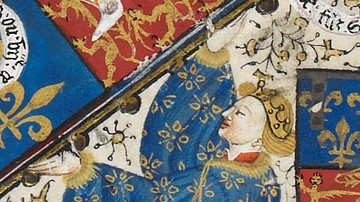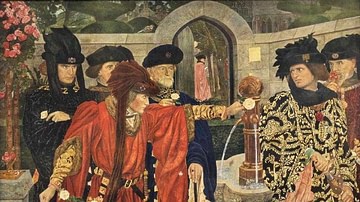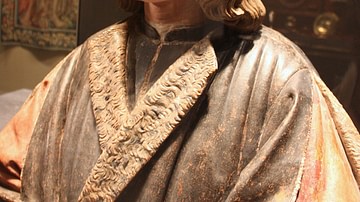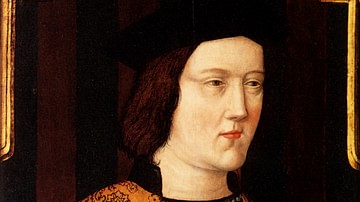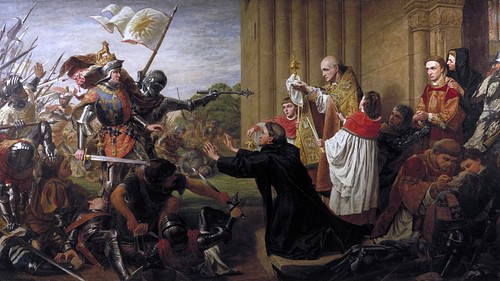
The Wars of the Roses (1455-1487) was a dynastic conflict between the English nobility and monarchy which led to four decades of intermittent battles, executions, and murder plots. The English elite was split into two camps, each centred around a branch of the descendants of Edward III of England (r. 1327-1377): the Yorks and Lancasters, who won.
The name of the wars derives from the livery badge of each side, even if they were not so commonly used at the time: the white rose of York and the red rose of Lancaster. The insane Lancastrian king Henry VI of England (r. 1422-61 & 1470-71) would be threatened by Richard, Duke of York (l. 1411-1460), whose son became King Edward IV of England (1461-70 & 1471-83). Edward was ultimately succeeded by his brother Richard III of England (r. 1483-85) whose infamous association with the death of Edward's young heirs, the 'Princes in the Tower', shocked the nobility. Thus the door was opened for the Lancastrian Henry Tudor to step in and take the throne following Richard's death at the Battle of Bosworth Field in 1485. Henry Tudor became Henry VII of England (r. 1485-1509), and, through his marriage to Elizabeth of York, he united the two houses and created a new one: the Tudors. The conflict may have had only a limited impact on the wider populace but it certainly shook up the nobility as families rose and fell. The conflict has never ceased to grip the popular imagination and has inspired peddlers of fiction ranging from Shakespeare to George R.R. Martin and the Game of Thrones television series.
The Name of the Rose
The romantic name for the dynastic conflicts which troubled 15th-century England, the 'Wars of the Roses', was first coined by the novelist Sir Walter Scott (1771-1832) after the later badges of the two main families involved (neither of which were actually the favoured liveries at the time): a white rose for York and a red rose for Lancaster. The division was a little more complex than merely these two families as each one garnered allies amongst England's other noble families, thus creating two broad groups: the Lancastrians and the Yorkists. Allies of either side were also liable to switch allegiances over the course of the conflict depending on favours, deaths, and opportunities. Another problem with the name is the fact that the dynastic conflicts were not wars but a series of intermittent battles, skirmishes, a few minor sieges, executions, and murder plots. It is very doubtful that the people living in 15th-century England ever considered themselves a part of a cohesive set of historical events we now put together under the handy label Wars of the Roses.
Causes of the Wars of the Roses
The causes of the Wars of the Roses are many and, as the conflict went on, so new actors and motivations arrived to perpetuate it even further. Perhaps the earliest cause was the action of Henry Bolingbroke who, in 1399, took the throne by force, made himself king Henry IV of England (r. 1399-1413) and then murdered his predecessor Richard II of England (r. 1377-1399). Henry was the first Lancastrian king (his father being John of Gaunt, Duke of Lancaster). Regicide had become a shocking but not unsuccessful political strategy.

Much closer to the outbreak of the wars was the start of the incompetent reign of Henry VI. The king had been thrust on the throne as an infant following the sudden death of his father, Henry V of England (r. 1413-1422). Surrounded by ambitious and unscrupulous regents and courtiers, the king's reign was marked by lawlessness in certain parts of the country and a failing economy. Then, just when Henry reached maturity, there was the final defeat to France at the end of the Hundred Years' War (1337-1453). The English barons were in hot disagreement over how to deal with France: take a more aggressive approach as Henry V had done, negotiate some sort of deal, or abandon mainland Europe altogether. One of the problems was money and the huge expense of military campaigns abroad. Henry, easily swayed by whoever caught his ear, was indecisive when decisiveness was most called for.
Henry VI was also unwise enough to involve himself in the personal disputes amongst his barons, further polarising the kingdom. This situation was only worsened in 1445 by Henry's decision to marry Margaret of Anjou (d. 1482), niece of Charles VII of France (r. 1422-1461). Some barons saw this as a capitulation to the French, and Margaret's obvious influence on the malleable and very un-warlike king was another bone of contention. As if Henry's unpopularity could not sink further, his choice of favoured courtiers, notably the unpopular William de la Pole, the Earl of Suffolk, made yet more enemies for the king. Even commoners were not happy, as indicated by the rebellion of 1450 led by Jack Cade which protested at the high taxes, perceived corruption at court, and absence of justice at a local level. The commoners might not have had any direct influence on government but the discord did perhaps give those nobles keen to overthrow the regime another excuse to do so beyond merely extending their own interests. With all these stresses, and given the mental problems of his maternal grandfather Charles VI of France (r. 1422-1461), it is perhaps not so surprising that Henry had a mental breakdown in 1453. It was likely sparked off by the final defeat to France and loss of all English territory there except Calais. Henry became so ill that he could not move, speak, or recognise anyone. In this situation, the kingdom needed a regent and so the problems of state really began to mushroom as England was fractured into two warring groups.

The Dukes of York
The barons of England had been increasing their wealth and power as a consequence of the corresponding demise of the Crown. Historians have noted a phenomenon which they call 'bastard feudalism'. Part of this process was the weakening of the Crown's hold over land, wealth, and political power at a local level. Large estate owners ruled their areas like kings and were able to build up their own private armies of retainers loyal only to them. Eventually, some of these barons became so ambitious they, remembering the success of Henry Bolingbroke, even considered themselves worthy of the role of king of England. With a little royal blood in their veins, a baron could persuade others to follow him, especially barons who were out of favour with the incumbent king. Such powerful political players have been called the 'over-mighty' by some historians as they were capable of toppling the rightful monarch. In addition, now that the wars in France were over, these 'over-mighty' men could employ all of their armed retainers and their wealth for their own private ambition at home.
The most mighty of all barons in this period was Richard, Duke of York. Richard had two things going for him. First, he was the great-grandson of Edward III of England and the nephew of the Earl of March who himself had claimed he was the legitimate heir to Richard II of England (r. 1377-1399). Second, he was the richest man in England. Add these two factors to the duke's ambition and military talent and the result was an extremely dangerous threat to Henry's already uncomfortable position on the throne. When Henry suffered his first episode of madness, the obvious choice for regent was Richard, and he was indeed made Protector of the Realm in 1454.
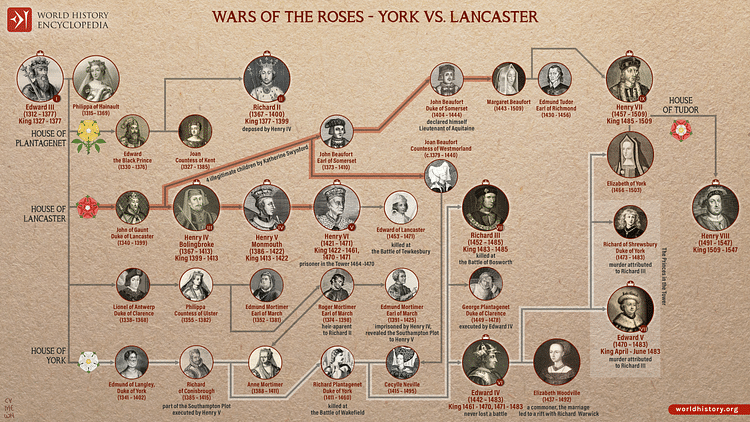
Curiously, opinion of Henry's reign was so low that Richard was seen as the champion of reform. It may be that the duke was bent on cleaning up the court and sorting out the kingdom but, eventually, he played his cards to win the jackpot: the Crown. First, Richard sought to be nominated as Henry's official heir (the king had no children at that time). The duke had powerful allies, notably the Nevilles of Middleham who were keen to have friends against their own personal enemy, the powerful Percy family. Richard, though, had two important enemies: Margaret of Anjou, who detested the duke, and Edmund Beaufort, Earl of Somerset, also a descendant of Edward III and as ambitious a noble as anyone. The Earl of Somerset was eventually dealt with on the battlefield - he was killed at St. Albans on 22 May 1455, the first battle of the Wars of the Roses. Queen Margaret proved a much more difficult opponent as she took over from her mad husband and led armies against the Duke of York. After defeat in Ludlow at the Battle of Ludford Bridge on 12 October 1459, Richard was obliged to flee to Ireland. Meanwhile, Parliament, the 1459 'Parliament of Devils', identified him as a traitor and disinherited his heirs.
Returning to England after his son Edward had defeated Queen Margaret at Northampton on 10 July 1460, the Duke of York persuaded Henry, who was now in the Tower of London, to name him as the official heir to the throne, a decision ratified by the Act of Accord of 24 October. However, with the coveted crown almost in his grasp, Richard was killed at the Battle of Wakefield on 30 December 1460 by royalists led, once again, by the queen. Richard's head was displayed on a pike at Micklegate in York and decked with a paper crown to remind everyone he had been a mere usurper. However, this was not the end of the Yorkists but only the beginning of their even greater rise.
Richard's son Edward took on the role as leader of the house of York and number one enemy of the king and queen. Edward of York had a trump card, his great ally, the immensely rich Richard Neville, Earl of Warwick (1428-71) who was so powerful he has become known as 'the kingmaker'. Edward proved a cause worth backing when he won the bloody Battle of Towton in March 1461, the largest and longest battle in English history. Henry VI was deposed while Edward became Edward IV, crowned the first Yorkist king on 28 June 1461. The wars then got a whole lot darker after Edward's reign was briefly interrupted when his old ally Warwick turned against him and reinstated Henry VI in 1470 (the 'Readeption'). Edward won back his throne on the battlefield the next year (at the battles of Barnet on 14 April and Tewkesbury on 4 May 1471) and the Earl of Warwick and Henry VI's only son were killed in the process. Queen Margaret was imprisoned and Henry was murdered in the Tower of London on 21 May 1471. It was a bloody affair but the Yorks seemed to have won the war.
Richard III & Henry Tudor
Edward IV's younger brother was Richard, Duke of Gloucester (b. 1452), and he would be the next central character in this deadly game of musical thrones. Richard had fought loyally alongside his brother prior to him becoming king and when Edward died unexpectedly, probably of a stroke, in 1483, Richard saw a chance for a dramatic promotion. Edward was officially succeeded by his son, another Edward (b. 1470), but he was only 12 years old. Yet again, the barons hovered around a juvenile monarch, jostling for supremacy and the most menacing of all was his uncle Richard.
The young and still uncrowned Edward V of England and his brother Richard (b. 1473) were imprisoned in the Tower of London where they became known as the 'Princes in the Tower'. Meanwhile, the kingdom was run by the Protector of the Realm, none other than Richard, Duke of Gloucester. The princes were spotted a few times in the Tower's grounds over the summer but then they disappeared. It was widely thought that Richard had murdered them - a general accusation adopted by later Tudor historians and William Shakespeare (1564-1616), who also painted Richard's reign as rather bleaker than it probably was. Significantly, the man to benefit most from Edward V's death was his uncle who had himself crowned Richard III on 6 July 1483 in Westminster Abbey. However, to take the throne via such a terrible crime was only asking for trouble, even Yorkists were shocked and so the Wars of the Roses took another dramatic twist.

The Lancastrians, although purged by Edward IV, had not gone away completely and they were now led by one Henry Tudor. Henry did have some royal blood in his veins via the illegitimate Beaufort line which descended from John of Gaunt, son of Edward III. This was not much of a royal connection, despite the legitimisation of the Beaufort line in 1407, but it was the best the Lancastrians could hope for after Henry VI had left no surviving heir. Henry Tudor, nevertheless, managed to gather about him some very useful allies. Besides outraged former Yorkist supporters, there were the Woodvilles - Elizabeth Woodville being Edward IV's queen, the Duke of Buckingham, and, across the Channel where Henry was in exile, Charles VIII of France (r. 1483-1498) who was eager to destabilise England and keep it off his own territories.
Perhaps the spark that reignited the Wars of the Roses was the death of Richard III's heir in 1484 (yet another Edward). Henry Tudor now only had one man between himself and the throne and a deeply unpopular one at that. In August 1485 Henry Tudor landed with an army of French mercenaries at Milford Haven in South Wales and marched to face Richard's army at Bosworth Field in Leicestershire on 22 August 1485. There, Richard was deserted by some of his key allies (Sir William Stanley and Sir Henry Percy), and the king was killed when he made a rash charge at Henry Tudor himself. The new king was crowned Henry VII of England (r. 1485-1509) on 30 October 1485. Henry still had to face a Yorkist revival centred around the pretender Lambert Simnel, but this was quashed at the Battle of Stoke Field in June 1487. This was the last act of the Wars of the Roses, even if there were some more minor revivals on the part of the Yorkists over the next half-century.
Impact of the Wars of the Roses
Besides the evident swapping of thrones between Lancastrian and Yorkist kings, one of the most significant consequences of the wars for history was Henry VII's foundation of the House of Tudor. Henry married Elizabeth of York, daughter of Edward IV in 1486, thus uniting the two sides. The king even created a new symbol for this new dynasty: the Tudor Rose which combined the roses of the Lancasters and Yorks. Henry's son succeeded him as Henry VIII of England (r. 1509-1547), and the Tudors, ruling until 1603, would oversee what is seen as a Golden Age for England.

The wars had not affected most of the general population as it was a conflict usually restricted to the nobility, even if some battles and campaigns would have caused death, destruction, and disruption in the areas where they occurred. In fact, there were 13 separate campaigns spread across fewer than 24 months of actual fighting over the entire period. Many areas of the country were completely unaffected. The wars did certainly affect the nobility, though, killing by one way or another half the lords of the 60 noble families of England. This is because many skirmishes involved only nobles and the old habit of taking hostages for ransom no longer worked because people would or could not pay and opponents had to be removed permanently from the game. Further, although many barons profited from the wars, by the end of them the king was firmly back in control of his kingdom, supervising taxes much better than previously and confiscating the estates of extinct families and political opponents. For most people this transfer of wealth backwards and forwards meant nothing; at the end of the wars the names might have changed but the 3% elite of the country still owned 95% of its wealth.
Finally, the wars have left their indelible mark on English culture as their twists, turns, and treachery have inspired both historians and fiction writers ever since. Tudor propagandists were keen to exaggerate the destruction of the wars and the villainy of the Yorkists in order to show themselves in a better light and their patron monarchs as the saviours of the country. William Shakespeare (1564-1616) was particularly interested in the period which forms a background to his historical plays Henry VI and Richard III and which provide some of the Bards' most memorable characters and oft-quoted lines. Even in the 21st century, the Wars of the Roses continue to inspire such authors as George R. R. Martin whose novels have in turn provided themes and characters for the television series Game of Thrones.

